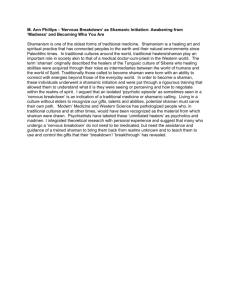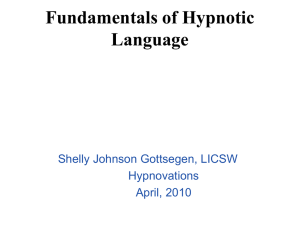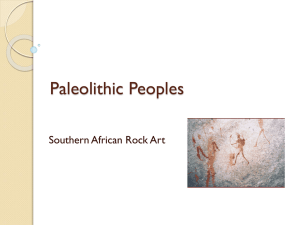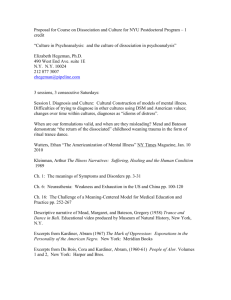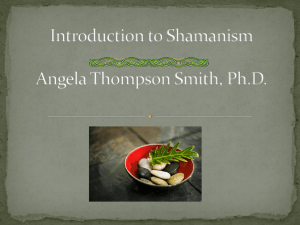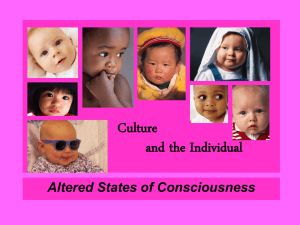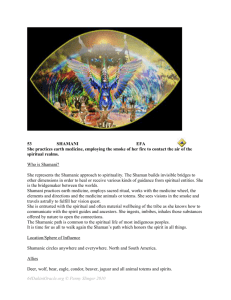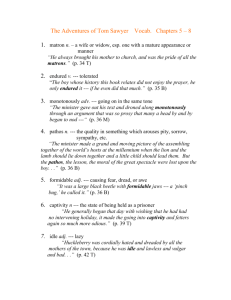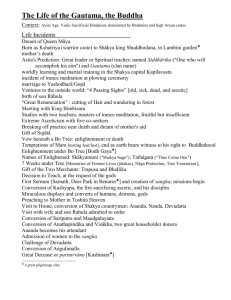Shaman
advertisement
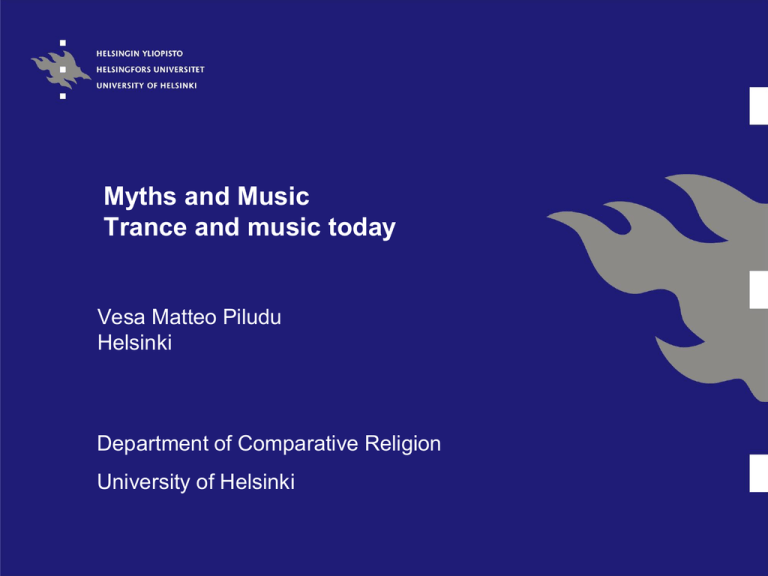
Myths and Music Trance and music today Vesa Matteo Piludu Helsinki Department of Comparative Religion University of Helsinki Trance? What is trance? ? Trance and ecstasy: two different things A state of consciousness connected with a direct contact with spirits, divinities or other spiritual entities The trance is connected with movements, dance, instrument playing, singing, storytelling, performing arts, sensory over stimulation Trance generally isn’t an individual activity, the rituals are more or less collective Trance’s hyperactivity Bewilderment, convulsions, trembling, yawing, noisy breathing Dance Singing in uncommon languages or codes Playing instruments Storytelling acrobatic displays sometimes: insensibility to pain Trance Trance isn’t provoked by drugs, even if sometimes some kind of drugs are used during the rituals Trance is still alive in different cultures and religions Trance is not only present in the so called ”native cultures” … it was very popular also in the cradle of the western civilization … Ancient Greece Music = from Muses (goddesses of inspiration) According to the ancient Greeks The Muses inspired music and poetry The singer-poet received the inspiration thought a state of creative trance It was a case of artistic inspiration trance The Muses inspired also other kind of artist Problems It is difficult to define exactly trance The scholars generally don't have any direct experience of trance … they never fall in trance In Latin America: cases of native scholars initiated in trance cults Trance is an umbrella-concept Trance is an umbrella-concept or a grapefruit-concept It include many different phenomena or many different kind of trances Scholars in total grapefruit confusion The scholars often confused one trance with another one The connection with the music wasn’t clearly expressed Results: scientific chaos chaotic melting pot ??? ”Music and trance” – Gilbert Rouget Gilbert Rouget is one of the first scholars who create a clear typology of the trance states … … and analysed the relation between music and different kinds of trance Trances Inspiration or contemplative trance (dervishes, Tibetan Buddhism) Artistic inspiration trance (poetry, music according the Ancient Greeks) Prophetic trance (possession by a spirit to predict the future) Mediumship (possession by a dead spirit) Ritualized possession trance (vodou, candomblé) Shamanic soul-fly trance Shamanic expulsion of evil spirits from the body of the patient Possession healing trance Music and trance – Gilbert Rouget the ideological opposition between classic shamanism and possession rituals was theorized by Gilbert Rouget in his book ”Music and Trance” In the shamanic soul-fly, the soul of a human shaman is visiting the world of the spirits During the possession trance the spirit are visiting the human world, taking possession of an initiate Shamanic soul-fly trance The shaman sing, tells, plays instruments, acts and falls in trance in the shamanic trance one of the shaman's soul leaves the body and travels in other worlds with the help of certain animal spirits The shaman is not under the control of the spirits, he controls his helping spirits … that are generally in animal form The shamans is the ”rider” and the helping spirits are the ”horses” The shaman remember his travels in the trance state Shaman Original world ”shaman” from the Tungus-languages Complicate etymology … Sha = to know Shaman = the one who knows, tietäjä The shamans know … myths, rituals, songs, secrets, secret languages, origins … and how to find the roads to the other worlds … Other languages have other world for the shamans: Kam, paje … The word shaman was once restricted to Siberia … now extends all the way to Southern Asia, the two Americas and Oceania The word shamanism has come to include religious practices of the greater diversity Shaman according to Hulktrantz and Hoppal The shaman … mediate between the world of humans and the spirit world (heavenly spirits, animal spirits, forest masters, spirits of the dead) always in the interest of some collective goal The shaman maintain the communication between the human community and the transcendental dimensions Human community Chukchi Shamanic Ritual from Siberia http://www.youtube.com/watch?v=3JJw5bTfUL8 Spirit’s community Reciprocity, fight or ambiguity The relation between the shamans and the spirits could be based on respect, reciprocity or even alliance… (shamans and certain divinities, forest spirits) The relation could be contrastive: the shamans should fight against evil spirits causing suffering, illness or sickness (evil spirits, ghosts, spirits of illness) The relation could be ambiguous … the same spirits could cause disaster or give solution to some urgent problems The contact with the spirits is mediated by trance ”Goals” of the shamanic fly An ill person has lost one of his souls, that is somewhere in another dimension (sky, underground) … the shaman should find the soul and bring it back to the suffering patient To communicate with the divinities, master spirits, dead souls To give omens or to discover the origin or causes of something To change the courses of the events (misfortune, weather) To fight against another spirit or shaman To lead the souls of the dead into the underworld In general: to solve a crisis regarding a member of his community Trance and music The music is very important to achieve a shamanic trance state But the trance couldn’t be caused only by music, dance or some kind of drug … The shaman could go in trance because he believe in the trance ideology and in the existence of different spirit worlds Shamanism is a culture, a world-view, a philosophy The shaman is well trained in trance his trance is ritualized, not spontaneous A long road Shamanism is a long, painful road … Passing through election … initiation … learning … practice … 1. Election Generally a man or a woman could be elected shaman because his father is a shaman (hereditary shamanism) By his own will (very uncommon) … because is chosen by the clan (rare) … Shamanism is a hard taks By the “call of the spirits” (common) Call of the spirits The body or mind of the future shaman is somehow “marked” by the “signs of the spirit” (call of the spirit) The future shaman pass through a sequence traumatic experience … illness … mental illness … spontaneous spirit trance … dreams … During this experiences the initiate is near to the gate of the dead realm … He learn the path to the other worlds Being sick and curing himself of illness … he is able to cure the others Shamanism is not hysteria The shaman is not an hysterical and shamanism isn’t a strange king of arctic hysteria caused by the difficult climatic conditions, as many anthropologist postulated We find shamans in the tropics! The shaman is someone who passes through states of hysteria (caused by initiator spirits) and overcomes the states of mental insecurity and pain Shamanic dreams During the period of the election … the shaman often dreams about a particular spirit … the initiator or elective spirit … The elective spirit sometime “make love” whit the shaman or “married” the shaman (alliance and change of the status of the initiate) Often elective spirit kills the initiate and tore it into pieces … or devours it It is a symbolic death (the initiate loose his previous status) The initiate contemplate is skeleton The soul of the initiate travel in the otherworld and learn secrets The elective spirit bring the initiate back to life (symbolical rebirth in the status of shaman) Elective spirits (eskimo) Elective spirits Jaguar initiator or elective spirit (Mexico) Bear initiator spirit devouring the initiate (Tlinglit) The bear hibernation as a model for the initiation Hibernation Death from the previous status Awakening Rebirth in the status of a shaman 2. Shamanic learning During the initiation time … the shaman learn with an older shaman … mythology the secret of the curative herbs per formative arts (singing and dancing) How to build a drum and the costume Sacrifice and other rituals Little by little learn to control his trance He acquire spiritual power and “extra” souls One of this soul is able to leave the body and travel in other dimensions Shaman’s spiritual power (aura) Shaman’s spiritual power (aura) 3. Learning to control the spirit helpers The initiate is not tortured anymore by the initiator spirit Generally the initiator spirit became the most important helping spirit The shaman now controls the helping spirits More helping spirits shaman control, more he is powerful he could transform itself into an helping animal spirit to travel into another world The soul could ride the helping spirit when he is travelling Helping spirits The helping spirits could be anthropomorphic or vegetal … often they are animals Some animal-spirit are the guide to the celestial world, others to the underworld … others to the water world (realm of the dead) The most powerful animal-helpers could travel in many or all the dimensions Ayami, Nanai, anthropomorphic helping spirit Ayami is the shaman's guide to the other world of the Universe. It tells the shaman all the mysteries and serves him during important shaman's rituals. The nine figures on its head are representations of the buchu and edgehe (shaman's advising spirits). Shaman and his tiger spirit Shaman as a spirit rider Shamanic fly Shamanic fly Shaman’s soul transformed into a bear The language of the animals During the trance, the shaman imitates the sounds and voices of the animal helping spirits He speaks a secret sacred language, called the "language of the animals" Learning from the bear helping spirit Animal-spirits have knowledge In the beginning of all things, wisdom and knowledge were with the animals; for Tirawa, the One Above, did not speak directly to man. He sent certain animals to tell men that he showed himself through the beasts, and that from them, and from the stars and the sun and the moon, man should learn Tirawa spoke to man thought his work Chief Letakofts-Lesa (Pawnee) to Natalie Curtis, 1904 Lakota bear doctor’s song “A root of herb you will eat At that place it stand A bear said this to me” The bear is the herbalist of the natural world It eats the same plant and roots the humans eats It knows about the healing plants and roots The Great Bear of the First Creation: a powerful helping spirit If a man is sick, I turn into a bear, the Great Bear of the First Creation. My fur is all white, but no polar bear, I'm the Bear of the First Creation. I lick my paws all over, seize hold of that man, squeeze him tight wherever it hurts him, then I blow all over his body, with my healing breath, the First Breath of the First Creation. Reindeer Chukchee c.1900 The bear hibernation as a model for the trance Hibernation as trance Deep trance: voyage in the dead world Travel in the underworld Awakening Return of the shaman in the world of the living beings Bears in the sky Blackfoot bear shaman (George Catlin, 1832) Nanai Bear shaman Nanai bear shamans Bear helping spirit (Nanai) Shamanic bear session From the Cd: Shamanic and narrative song of the Siberian artic – Nganasan Musique du monde – Siberie1 – track 12 Where? Kirjasto 10 Shamanic fly Shamanic soul-fly Hole of the world – Axis (pole) Hole and axis (Australia) World tree (maya) Axis mundi - mushroom Tree, mountain, axis mundi (vertical) Dark - Light, female - male (left – right) “Psychopomp” rituals (Nanai, Kasa Taori) River going to the Buni (realm of the dead) Cataleptic trance Figurative trance (acting, playing, telling singing during the fly) Shamanic ritual in Tuva (Siberia) http://www.youtube.com/watch?v=8AM1_erwOMY&NR=1 Ulla Pirttijärvi - De juoiggas http://www.youtube.com/watch?v=NI1ccC1XIQM&feature=related ARTIST: Ulla Pirttijärvi SONG: "De juoiggas“ (Hear the sound of the yoik) ALBUM: "Máttaráhku Askái"( In Our Foremother's Arms) released in 2002 on Warner/Finlandia. Gjallarhorn - Suvetar http://www.youtube.com/watch?v=BjLTrKuK_Wg Ritualized possession trance During the rituals (candomblé, santeria, vodoun) The spirits, animal or divinities … visit the human world … entering into the heads and the bodies of the possessed The possessed acquires the dance steps, the voice, and the behaviours of the spirit (divinities, animals and so on) … the trance is extremely ritualized The possession is voluntary. The possessed is trained to “welcome” the divinity Generally the possessed don’t play instruments The are skilled musicians playing … certain rhythms at the right moments … The possessed could sing The possessed is the ”horse” of the spirit, it is controlled by the spirits After the possession, the possessed don’t remember his acts Candomblé: Possessed by Iemanjá (goddess of the sea)
